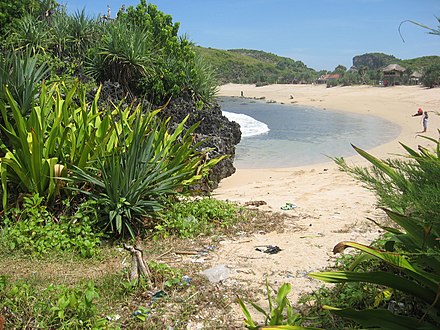Central Java - province of Indonesia, on island of Java
Central Java is the heartland of Javanese culture. This page covers the central third of the island of Java, encompassing the two provinces of Central Java and the Special Region of Yogyakarta.
Regions
Northern region.
Southwestern region.
Northeastern region.
Southern region.
Northwestern region.
Southeastern region.
Yogyakarta Special Region
Cities

- Magelang — the nearest large town to Borobudur with a splendid history from the Mataram period
- Pekalongan — a Batik city has become a part of UNESCO Creative Cities
- Purwokerto — the gateway to Baturaden Park (12 km from the peak of Mount Slamet) and the mighty Mount Slamet
- Semarang — the capital of Central Java province, an ancient seaport with preserved colonial legacies
- Solo (also called Surakarta) — a bustling city that has retained its authentic traditional Javanese nature
- Tegal — a lively north coast town with a strong colonial past
- Yogyakarta — the heritage city of Java and a semi-autonomous sultanate, in Yogyakarta Special Region
Other destinations
- Borobudur — the world's largest Buddhist monument
- Dieng Plateau — volcanic highland plateau with the oldest temples in Indonesia
- Gunung Kidul — beautiful beaches, in Yogyakarta Special Region
- Karangsambung-Karangbolong — an ancient geological national geopark site in Kebumen, Central Java region
- Karimunjawa — a marine park of 27 islands, well off the beaten track
- Mount Merapi — a perennially active and spectacular volcano
- Mount Merbabu National Park — just north of Mount Merapi
- Parangtritis — a beach to the south of Yogyakarta
- Prambanan — a collection of awe-inspiring Hindu temples
Understand
History
Central Java has been inhabited by humans since the prehistoric era. Remains of a Homo erectus, known as "Java Man", were found along the banks of the Bengawan Solo River, and date back to 1.7 million years ago. The present-day Central Java was once under the control of several Hindu-Buddhist kingdoms, Islamic sultanates, and the Dutch East Indies colonial government. Central Java was also the centre of the Indonesian independence movement. As the majority of modern-day Indonesians are of Javanese descent, both Central Java and East Java have a major impact on Indonesia's social, political, and economic life.
Culture
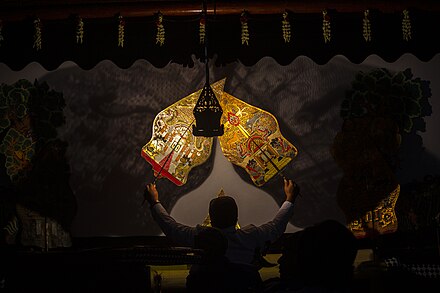 Javanese culture is very close to Central Java. Pertunjukan Wayang (Javanese puppet show) is one of the traditional performances that can be enjoyed regularly in several big cities, either wayang kulit in Yogyakarta or wayang wong in Semarang and Solo which are always accompanied by gamelan, a traditional Javanese musical instrument.
Javanese culture is very close to Central Java. Pertunjukan Wayang (Javanese puppet show) is one of the traditional performances that can be enjoyed regularly in several big cities, either wayang kulit in Yogyakarta or wayang wong in Semarang and Solo which are always accompanied by gamelan, a traditional Javanese musical instrument.
Javanese dance is commonly involving slow movements and graceful poses. It has somewhat of a meditative quality and tends to be more self-reflective, introspective, and oriented toward self-understanding. Sendra Tari Ramayana (Ramayana Ballet) is an annually traditional Javanese dance performance conducted in Prambanan.
Religion
Islam is the majority religion in Central Java at about 97% of the population, with Christianity in second place at about 2%, and the rest is a smattering of other religions.
Read
- Java: Guide to Borobudur & Prambanan, Approach Guides. Detailed tours of Borobudur and Prambanan including art and architecture reviews also advice for getting the best cultural experience.
- Javanese Culture, Koentjaraningrat. Detailed accounts of Javanese history, peasant and urban culture, religion, and values and symbols.
- Batik, Traditional Textiles of Indonesia, Rudolf Smend. Having collected historical batik for over thirty years and published two books on the subject, Rudolf Smend has invited his friend and fellow batik specialist Donald Harper to contribute to this publication as well. They represent an exquisite cross-section of the batik production of Java--the most important batik-producing region in the world.
Climate
The average temperature in Central Java is between 22–32 °C (71–89 °F) and the relative humidity varies between 60% and 95%. The highest average annual rainfall of 3,990 mm with 195 rainy days. The cooler area in Central Java are Bandungan, Dieng Plateau, Kopeng, and Tawangmangu.
Time
Central Java is in the UTC+7 time zone (known in Indonesia as WIB, Waktu Indonesia Barat), the same as Thailand and Vietnam.
Electricity
Electricity is supplied at 220 V, 50 Hz. Outlets are the European standard CEE-7/7 "Schukostecker" or "Schuko" or the compatible, but non-grounded, CEE-7/16 "Europlug" types.
Tourist information
- Central Java Province
- Tourism Information Centre, Jl. Pemuda No.147, Sekayu, Semarang, +62 24 3515451.
- Special Region of Yogyakarta Province
- Government Tourist Information Center, Jl. Malioboro No.16, Suryatmajan, Yogyakarta, +62 274 566000.
Talk
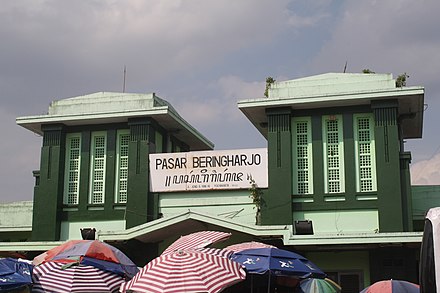 Indonesian (Bahasa Indonesia) is the official language of education and business. The majority of Central Java's population also speaks Javanese, a related but mutually unintelligible language. In the southwest of the region, near the boundary with West Java, Sundanese is also spoken. English and sometimes other European languages are widely understood in the major tourist areas.
Indonesian (Bahasa Indonesia) is the official language of education and business. The majority of Central Java's population also speaks Javanese, a related but mutually unintelligible language. In the southwest of the region, near the boundary with West Java, Sundanese is also spoken. English and sometimes other European languages are widely understood in the major tourist areas.
Javanese script also appears on street name signs and signboards for various places including airports and markets, especially in Solo and Yogyakarta.
Get in
By plane
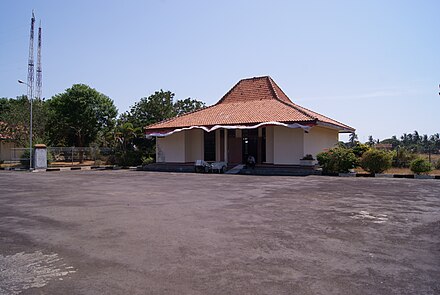
Smaller airports are in Cilacap (IATA: CXP), Purbalingga (IATA: PWL), Cepu (IATA: CPF) with flights to Jakarta and Karimunjawa (IATA: KWB) with flights to Semarang and Surabaya.
By train
Purwokerto, Yogyakarta, Solo and Semarang are well connected to other cities by rail serviced by Kereta Api Indonesia, providing classes for all budgets. Cities and towns in Central Java often have more than one station, a legacy of the many private railway lines of the colonial era.
By bus
Frequent interprovincial buses (named AKAP for Antar Kota Antar Provinsi, intercity/interprovince) connect many cities in Central Java with cities in Western Java and East Java. There are also a few long-distance buses to Sumatra and Bali.
By boat
Semarang's Tanjung Emas port has services to ports in Kalimantan, including Banjarmasin, Pontianak, Kumai, Ketapang and Sampit.
Get around
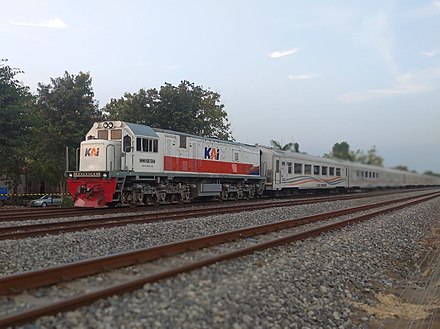
By train
The region is well served by trains with two main lines, one along the north coast linking Blora, Cepu, Grobogan, Pekalongan, Semarang, and Tegal, with stops in between. The southern line links Solo and Yogyakarta with Purwokerto, Kebumen, and small towns on the south coast. Both lines continue through to Jakarta in the west and Surabaya in the east. The loop line Joglosemarkerto train connects the north coast to the south coast of Central Java. The trains are comfortable and run to schedule.
The electric multiple units (EMU) serve the route from Yogyakarta to Solo and vice versa. It is operated by KAI Commuter. The schedule is from 05:00 to 19:00 with a 1- to 2-hour departure break.
The line in the northeast of the region linking Semarang with Jepara and Kudus is long-disused despite still being shown on many maps.
By bus
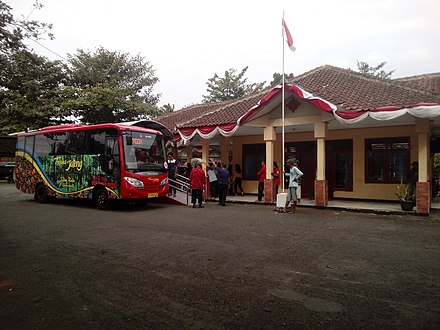 Buses are widespread, servicing cities (named AKDP for Antar Kota Dalam Provinsi, intercity in the province), towns and to a lesser extent, rural areas. There is a public bus called TransJateng bus which serves some areas in Central Java.
Buses are widespread, servicing cities (named AKDP for Antar Kota Dalam Provinsi, intercity in the province), towns and to a lesser extent, rural areas. There is a public bus called TransJateng bus which serves some areas in Central Java.
By car
The region's road network is in modest condition, as the toll road from the west to east in Central Java has been finished. Most inter-city roads are still two-lane affairs of variable quality.
Having said that, the car is a convenient way to cover some of the large distances in the region. Hiring a car with a driver can be cost-effective if you are in a group, and allow more flexibility to get off the beaten track.
For one of the ubiquitous Toyota Avanzas (or similar size compact MPV) expect to pay in the region of Rp650,000 (in town) or Rp900,000 per day (out of town) per day, all-in i.e. driver's fee, all parking and toll costs, petrol, and food and accommodation for the driver. This will carry five people, without large amounts of luggage. For the larger Toyota Innova (or equivalent) budget another Rp100,000 per day.
By taxi
There are taxi services in all cities and large towns. In general, the standard is satisfactory. Meters are fitted and will mostly be used. Most will be happy to take a longer job, either on the meter or by agreed price, and wait for you while you do some sightseeing or go shopping.
Taxis are licensed for a defined area, which may be quite large and cover some of the hinterlands outside the town or city where they are based. It might be an option for a day of out-of-town sightseeing.
Taxis are normally happy to take fares to neighbouring towns or cities, sometimes with a defined surcharge if it is a longish distance. They will usually not be able to operate in that city though, when they arrive, so will need to drop you at your specified destination and then head straight out of town again.
Some taxi companies in the region have fleets of the compact MPVs rather than sedans, which are useful if travelling in a bigger group, or you just want more leg room.
By ojek
Motorcycle taxis are common all over Central Java. Where ojeks really come into their own when travelling through the province is to get to some rural places that a car might not make it to: a hidden temple, beach, or some such. A lot of Java's (especially Central Java's) ugliest development takes place by the side of the major roads – driving along can be a dispiriting experience of unfinished concrete draped with tatty advertising banners. But head off the road, even just one kilometre, and you could be in a tranquil, green haven of rice terraces and clay-tiled villages. Consider using an ojek to make the break.
By ride-hailing services
The taxi and ojek industries have been rocked by the rise in smartphone apps allowing ride-hailing. Go-jek and Grab operate in many cities and large towns in Central Java.
It is worth getting an Indonesian SIM card with data to allow you to use them. Also consider learning enough Indonesian or Javanese to talk to the driver who will normally call you straight after accepting the job, to confirm your location.
By becak
Becak (BAY-cha') are pedicabs used for travelling short distances in places such as residential areas and around traditional markets. The driver sits behind the passenger and turns the pedals. They are found in all towns and cities in Central Java. Becaks are the most expensive means of transit but are good value for money considering the human effort that goes into it. Good communication skills are vital to prevent getting overcharged. Agree on the cost beforehand, and haggle for the best price.
By boat
Ferries to the Karimunjawa archipelago leave from Jepara, Semarang and Kendal, just to the west of Semarang.
See
Pre-colonial sights
 The region is best known for its two A-list UNESCO World Heritage Sites.
The region is best known for its two A-list UNESCO World Heritage Sites.
Borobudur is an ancient Buddhist stupa and temple complex dating from the 9th century, and is the single most visited attraction in Indonesia. That brings with it some issues and the site can be over-run. Visitors keen to really enjoy the undoubted magnificence of Borobudur should consider staying the night in the area and visiting early the following morning before the hordes of day-trippers arrive. There is a growing choice of accommodation in Borobudur village itself, and sunrise entrance packages to the candi are available.

The nearby Queen Boko Palace was an 8th-century giant and complete Javanese palace and now stones that once support its structures, still standing in its former glory. It has magnificent views down over Prambanan.
Both Borobudur and Prambanan are easily combined with a visit to the ancient city of Yogyakarta, and these three destinations account for the vast majority of visitor arrivals in the region. Yogyakarta is the undoubted cultural capital of Java with a wonderful palace (kraton) and many historical attractions.
Demak on the north coast of Central Java, is the home of one of the oldest mosques in Indonesia, Masjid Agung (lit. "Great Mosque"), as well as Sunan Kalijaga Cemetery. Nearby Semarang is home to several Buddhist, Hindu and Confucian temples, as well as mosques and churches, and nearby Bandungan offers the historic Gedung Songo (lit. "9 Buildings") temple complex, which has 9 Hindu shrines in it, as well as various activities for families and hikers to enjoy.
Pre-historic site
Another UNESCO World Heritage Site, Sangiran Early Man Site in Sragen near Solo. Sangiran is recognized by scientists to be one of the most important sites in the world for studying fossil man. Pithecanthropus erectus ("Java Man", now reclassified as part of the species Homo erectus), were found here.
Colonial architecture
Old Semarang, the original part of the city has many Dutch-era buildings; Lawang Sewu (lit. "1,000 doors"), located at the Tugu Muda roundabout intersection (which is also home to a museum and a government office) in Semarang, is a large complex of Dutch buildings featuring stain glass windows and numerous doors which was used by the military, the Japanese during their World War II occupation of Indonesia, and prior to that the Dutch as the office of the railway system, prison, hospital, and barracks. Supposedly, Lawang Sewu is haunted by over 30 different supernatural beings but you must be very talented to see even one after surveying the entire grounds from the foundation to attics and water towers! Also, the old town Kota Lama presents buildings with numerous architectural variations from the colonial era.
Steam trains
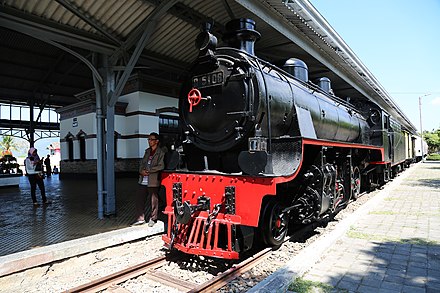 Perhaps more for aficionados of steam, but there is a good collection of steam locomotives in Central Java. The best collection is in the railway museum in Ambarawa just south of Semarang, which are run from time to time. There are also some in at the forestry museum in Cepu, remnants of the teak logging industry. The sugar cane factories also used to use them. On high days and holidays, a steam locomotive runs up and down the main street in Solo.
Perhaps more for aficionados of steam, but there is a good collection of steam locomotives in Central Java. The best collection is in the railway museum in Ambarawa just south of Semarang, which are run from time to time. There are also some in at the forestry museum in Cepu, remnants of the teak logging industry. The sugar cane factories also used to use them. On high days and holidays, a steam locomotive runs up and down the main street in Solo.
Natural sights
The Dieng Plateau is a little off the beaten path. This volcanic highland plateau north of Wonosobo is home to the oldest standing structures in Indonesia (Hindu temples dating from the 8th century). But it is the scenery that draws most visitors here. Spectacular conical volcanoes, steaming sulphurous pools and eerie mountain lakes make for an almost other-worldly landscape, not to mention the severe environmental damage being done by intensive agriculture.
Do
Getting out into nature
Let's be realistic, Central Java is one of the most densely populated parts of the planet. Pretty much everything you see in Central Java will have been touched by the hand of humankind. The most you can hope for will be getting out to somewhere green, away from the unfinished concrete and bright yet fading paint jobs of the towns.
Climbing volcanoes
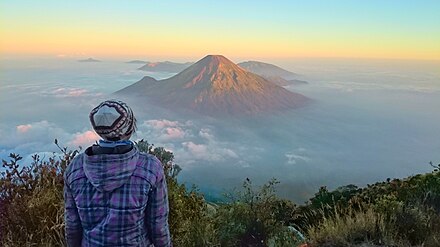 Heading up a mountain is one way to see some nature, and Central Java offers some spectacular options.
There are five volcanoes in the province in the high category, which means over 3,000 m in elevation and 1,000 m prominence above the surrounding landscape. These are Slamet, Sumbing, Sindoro, Merbabu and Lawu (shared with East Java). Merapi and Ungaran are medium, being between 2,000 m and 3,000 m in elevation and with over 1,000 m of prominence. Mount Muria on the north coast is in a lower category, having an altitude between 1,000 m and 2,000 m and more than 1,000 m of prominence. Mount Prau near the Dieng Plateau, and Mount Telomoyo, and the outlier of the Merbabu massif are also interesting and make exciting hikes.
Heading up a mountain is one way to see some nature, and Central Java offers some spectacular options.
There are five volcanoes in the province in the high category, which means over 3,000 m in elevation and 1,000 m prominence above the surrounding landscape. These are Slamet, Sumbing, Sindoro, Merbabu and Lawu (shared with East Java). Merapi and Ungaran are medium, being between 2,000 m and 3,000 m in elevation and with over 1,000 m of prominence. Mount Muria on the north coast is in a lower category, having an altitude between 1,000 m and 2,000 m and more than 1,000 m of prominence. Mount Prau near the Dieng Plateau, and Mount Telomoyo, and the outlier of the Merbabu massif are also interesting and make exciting hikes.
Waterfalls
With plenty of mountains and plenty of rain, there are bound to be plenty of waterfalls. Within striking distance of Semarang alone, you can choose from the mighty Curug Sewu in Kendal, Curug Lawe and Curug Semirang in Ungaran, also the famous, Grojogan Sewu in Tawangmangu. Many more remain to be discovered. Just ask around for the nearest curug (CHOO-roog).
Buy
Textiles
Batik
Batik, Indonesia's national fabric, is synonymous with the culture of Java itself. Batik making in Java is an ancient tradition that has been passed down through generations. A wax-resist dying technique is used, in which melted wax is applied to the fabric using a canting (CHANT-ing), a tiny metal cup with a spout. It is held like a stylus and used to cover the pre-drawn pattern lines. It needs painstaking precision as the patterns can be extremely complex. This method is called batik tulis, meaning written batik. When dyed, the areas covered in wax will not take the dye. The wax is later removed by washing. This process needs to be repeated many times to build up a multi-coloured cloth. Batik patterns are rich in meaning, such as the Sidomukti pattern that symbolizes prosperity and happiness and is worn during weddings. Some patterns used to signify social status and hierarchy, such as parang, which used to be exclusive to the nobility. The traditional method is now threatened by mass-printed batik. In 2009, UNESCO designated Indonesian batik as a "Masterpiece of the Oral and Intangible Heritage of Humanity". The declaration is aimed at helping to save traditional batiking.
Batik is produced across Java but Central Java is often considered as its home. There is a dizzying variety of styles to choose from. Each town has its special motifs and colourways, from the rich red browns of Solo and Jogja, to the Chinese and European influence of Lasem in Rembang on the north coast, and the unusual black, cream and indigo colours of the batik from Bakaran near Pati. Solo boast the districts of Kampung Kauman and Laweyan, home to traditional batik merchants, and three of Indonesia's biggest batik manufacturers, Danar Hadi, Batik Keris and Batik Semar all based there.

Batik if, of course, the pre-eminent cloth of Java, and there will be opportunities to buy wherever you turn. But batik is not the only cloth being made in the region.
In Klaten, between Yogyakarta and Solo, the striped cotton cloth known as lurik is still being woven, in traditional narrow bands, often on back looms. You will most frequently see it, mostly blue or black, being used by market traders to strap their baskets to their backs. You will also see Javanese men in traditional dress wear it with broader stripes in the surjan jackets.
Around Jepara, especially the village of Troso, there are weavers using jacquard looms and also making cloths using the ikat process.
There is an increasing amount of dyeing being done with natural rather than chemical dyes. On the coast, you might find batik dyed in the soft browns and greens derived from mangrove leaves.
One lurik producer working in traditional and modern colours is:
- Lurik Yojo, Jogja, +62 815 688-5886. Traditional back-loomed lurik cloth and hand-drawn batik in natural colours. 2017-11-19
Coffee and tea
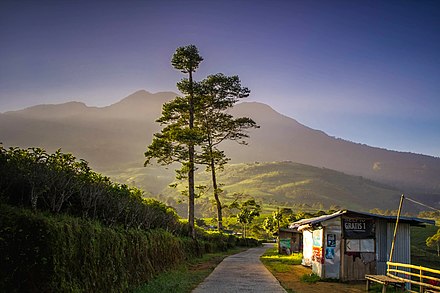 There is a lot of excellent coffee grown in Central Java, both arabica and robusta. The area around Temanggung is particularly noted as a coffee growing area, but it will be found growing wherever the altitude is high enough.
There is a lot of excellent coffee grown in Central Java, both arabica and robusta. The area around Temanggung is particularly noted as a coffee growing area, but it will be found growing wherever the altitude is high enough.
Traditionally, the preference has been for a very dark roast, with beans ground superfine to a powder. This has sometimes made it difficult to differentiate between styles, but things are changing. Small producer groups are starting up, preparing different levels of roast and grind, and packing airtight to preserve freshness. Look out for suppliers working with local farmers on just about any volcano you go to. One brand to look out for is:
- Kopi Petruk (Petruk Coffee), Deles Indah RT27/009, Sidorejo, Kemalang, Klaten (From growers on the eastern slopes of Mount Merapi), +62 815 7806-3198, petrukkopi16@gmail.com. From the Lintas Merapi community group. Arabica beans and ready-ground, identified by the preparation process, roasting date, depth of roast, altitude of the plantation, and the farmers' group who grew it. Available in the delicatessen attached to the Mediterranea restaurant in Jogja. Rp65,000 for 250g beans 2017-11-19
You may be offered the fabled kopi luwak, from beans pre-digested by palm civets, while you are in the region. It is almost impossible to validate whether what you are being offered has been processed by truly wild civets, or even by any civet at all. Be aware that kopi luwak is also produced from caged civets in unnatural and unhealthy conditions. Please think twice before buying.
Tea is less widespread but there are a number of plantations across the province, on the slopes of Mount Lawu, Mount Slamet and the Dieng Plateau. It should be possible to buy loose-leaf tea from any of them. Tea from the Tambi plantation near the Dieng Plateau comes in attractive boxes decorated with wayang figures.
Upcycling
Indonesia is drowning in garbage. Innovative craftspeople are using some of it to make attractive and useful items - wallets, bags, and jewellery, for example. They are using car tyres, old mobile phones, discarded clothes, plastic shopping bags, used oil drums, and so on. Also handicrafts from water hyacinth which is a weed in Lake Rawapening, Ambarawa. Sometimes the producers are local communities who have received training, and all of the proceeds go back into the local community.
Horn
Magelang has some crafters working with cow and buffalo horn. Items start from small simple bowls and spoons, through larger rice scoops and hair pins, up to extravagant statuettes for the coffee table. The sellers and stalls around the Borobudur complex of candi always have a good selection, but you'll need to haggle as though your life depends on it.
Stone carving
If you have a very generous luggage allowance you may like to pick up a Buddha or other statuette carved from the volcanic stone of Merapi. The villages of Muntilan and Mungkid on the road between Magelang and Jogja are the places to look. At the very least, buy a proper Javanese cowék (CHOH-weh') and munthu (MOON-too), the Javanese mortar and pestle.
Food souvenirs
 Look out for the distinctive oleh-oleh from each part of the region:
Look out for the distinctive oleh-oleh from each part of the region:
- Bakpia (bah'-PEE-yah) — the small, sweet pastry filled with mung bean paste from the Pathok district of Jogja.
- Bandeng presto — on the other hand, you'll be clutching a bag of these pressure-cooked milkfish, as you board the bus out of Semarang.
- Enting-enting gepuk — Salatiga peanut snack.
- Getuk — a Javanese sweet dish made from cassava. The famous are Getuk Trio from Magelang and Getuk goreng from Purwokerto.
- Jenang — palm sugar and coconut milk fudge from Kudus.
- Lanting — a traditional Kebumen snack made from cassava that has been crushed, seasoned and subsequently fried.
- Lumpia Semarang (LUMP-ee-ya) — Semarang's largish spring roll, heavy on the bamboo shoots.
- Sale pisang — sweet banana dish from Cilacap.
- Telur asin Brebes — Brebes salted duck egg.
- Wingko Babat — if you had a spare hand, you'd have a box of this grilled coconut and sticky rice cake.
Eat
The food of Central Java is renowned for its sweetness, and the dish of gudeg (GOO-duhg), made from jackfruit, is particularly sweet. Yogyakarta is renowned for its ayam goreng (fried chicken) and klepon (KLUH-pon), green rice-flour balls with palm sugar filling. Surakarta's (Solo) specialities include nasi liwet (rice with coconut milk, unripe papaya, garlic and shallots, served with chicken or egg) and serabi (coconut milk pancakes topped with chocolate, banana or jackfruit). Some insist that in a country of interesting cuisine, the best hails from Central Java. That may or may not be the case, but several wonderful dishes originate from this region. These include:
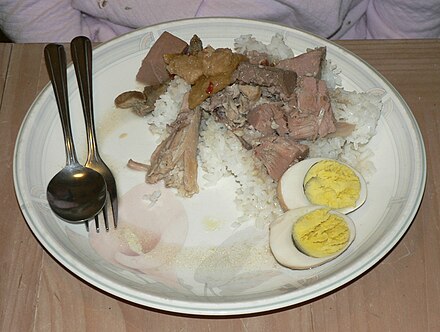
- Gudeg — a coconut-infused stew of young jackfruit, chicken and hardboiled eggs with a subtle sweet and savoury taste. Vendors all seem to have their own secret recipes, but the flavour base usually includes bay leaf, coriander, candlenut, onion, garlic, galangal, ginger, palm sugar, and unusually, teak tree leaves. This is a Yogyakarta speciality. Best tried in Yogyakarta but you will find it elsewhere. The side dish of gudeg is sambel krecek, cow or water buffalo skin crackers cooked in spicy coconut milk sauce.
- Lumpia Semarang — spring rolls could almost be the national dish of Indonesia, and the Semarang variety is one of the very best. Fillings vary but always include bamboo shoots. The dipping sauce might be sticky brownish garlic sauce and eaten with whole young scallion.
- Mangut — a spicy coconut milk-based smoked fish soup. The fish which are often used, iwak p (stingrays), manyung (ariidae), and lele (airbreathing catfish).
- Nasi Bogana — this convenient dish has almost fast food status across Indonesia these days, but it originated from Tegal on the northern coast of this region. White rice accompanied by a whole host of other possibilities is tightly wrapped in a banana leaf packet. It can then be heated by steaming at any time inside the packet - hence the convenient fast food tag. Accompanying dishes could be chicken curry, tempeh (fermented soya beans), tofu, egg, dendeng (spicy beef jerky), chicken livers... the list goes on. Most likely is a combination of them all. If you are travelling on a budget, keep an eye out for Nasi Bogana street hawkers in any city or town.
- Opor ayam — chicken cooked in coconut milk, usually eaten with ketupat (compressed rice cake). Eaten all year round, but also eaten as the celebratory meal at the end of the fasting month. Kind of a Javanese Christmas or Thanksgiving turkey. Having to eat it for days on end during that holiday period can result in an opor-dose.
- Pecel — said to originate in East Java but found widely in Central Java, this is a dish of steamed vegetables in peanut sauce. Though superficially similar to the ubiquitous gado-gado there are key differences. Pecel has only steamed beansprouts, spinach, cabbage and green beans. None of the boiled egg, potatoes, beancurd or pressed rice cake that gado-gado has. Pecel sauce has a good dollop of palm sugar, making it a bit sweeter and glossy red compared to the pale brown of gado-gado sauce. The key flavouring in pecel sauce is kencur, an aromatic rhizome related to ginger.
- Pindang Serani — this fiery, sour fish soup from the north coast may or may not take its name from the Christian (nasrani) Portuguese adventurers who made their way along the north coast early in the 16th century, leaving behind a fort on the coast at the foot of Mount Muria. All the spicy astringency will clear away the gloopy sweetness of too much gudeg.
- Soto Kudus — the nationwide family of soupy rice is represented in Central Java by the buffalo- or chicken-based, warmly-spiced version in Kudus, and further to the west on the north coast, the popular sauto which is soto pimped with fermented soybean paste, tauco, to give it umami depth.
- Thiwul (TEE-wool) — in the Gunung Kidul region to the southeast of Jogja life has been desperately bleak on the poor, dry soils of the limestone hills. Poverty has driven the people to adapt cassava to be eaten in place of scarce and expensive rice. The cassava is chopped and treated to create a granular, savoury 'grain'. Not eaten widely now as living standards have improved, it can still be found, and makes a tasty alternative to rice.
The angkringan is a popular type of eating stall in Central Java, named after the shoulder pole traditionally used to carry the baskets containing the food. They often serve tiny parcels of rice and a savoury side, wrapped in a banana or waxed paper packet. Due to the small portion, they are known as nasi kucing or sego kucing in Javanese meaning cat rice: just enough for a cat to eat.
Nasi pincuk is a small portion of rice with a small portion of dishes arranged on a banana leaf. It is relatively cheap, but you need maybe two or three to fill up. Usually served by an old lady with a basket on her back.
Drink
 Being a predominantly Islamic region, alcohol can be a little difficult to find outside the few licensed hotels and restaurants. Supermarkets and mini-markets may have a discreet supply of beer, but rarely will it be chilled. Wine, when available, will be eye-wateringly expensive.
Being a predominantly Islamic region, alcohol can be a little difficult to find outside the few licensed hotels and restaurants. Supermarkets and mini-markets may have a discreet supply of beer, but rarely will it be chilled. Wine, when available, will be eye-wateringly expensive.
A kind of local alcohol, ciu, is made and you may sometimes be offered it. Drink it at your own risk.
Besides socialising, another reason to drink is to stay hydrated. One of the pleasantest ways to do that in Central Java is with fresh, young coconut water degan (DUH-gan). Look for the pile of used coconut husks by the side of the road. The top will be chopped off a whole one, and a straw stuck in. That's all that's needed. You may be offered sugar syrup or some other flavouring, or ice. Up to you. The bonus is the jellyish flesh you get to scrape out with a spoon. In a restaurant they will do all for you, and tip it into a glass.
Sleep
With both the well-developed tourism industry and business and industry sectors, there are plenty of sleeping options in the region, from the simplest of backpacker dorms, through the plain, cheap business hotels, and charming boutique hotels, to the most extravagant five-star luxury.
All of the major national and international hotel chains are represented in the cities of Semarang, Jogja and Solo, and are now starting to appear in other towns too.
If you have only one or two days to visit, choose Jogja as your hub, because of the number of sightseeing options.
Stay safe

- Road safety is your major concern — it is recommended to take a local driver. Wear your seatbelt and, if possible, avoid long night drives.
- This is an active volcanic and seismic region — there was a major earthquake south of Jogja in 2006 and Mount Merapi, to the north of Jogja, erupted in 2010. Take heed of official instructions. Even if it is not on alert, climbing a volcano often requires a permit from the national park authorities and they will know of any local risks.
- Risk of violent crime is low — but there is always the chance of petty pilfering and pickpocketing. Keep an eye on your belongings.
Go next
- West Java — despite being on the island of Java, it has a separate Sundanese culture.
- East Java — for more national parks and volcanic scenery.
- Kalimantan — flights from Semarang allow you to hop across the Java Sea, in search of the orangutan of Tanjung Puting National Park, or on to Kuching through Pontianak.
- Bali — direct flights from Semarang, Solo, and Jogja.
